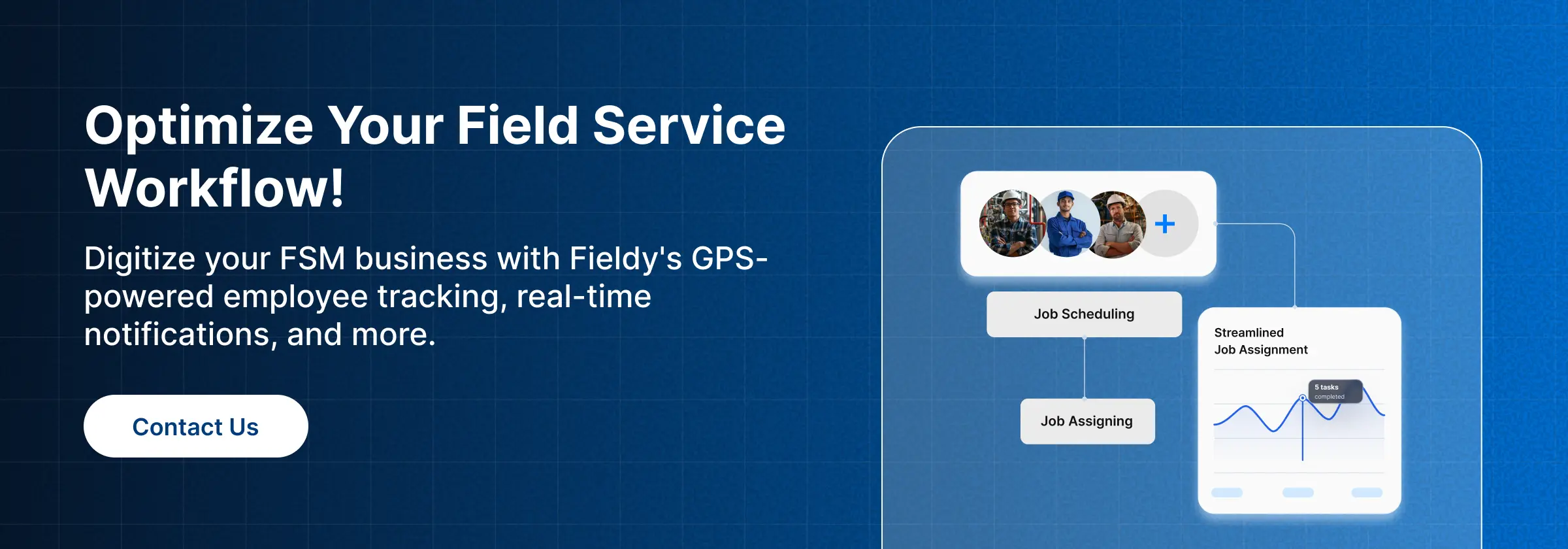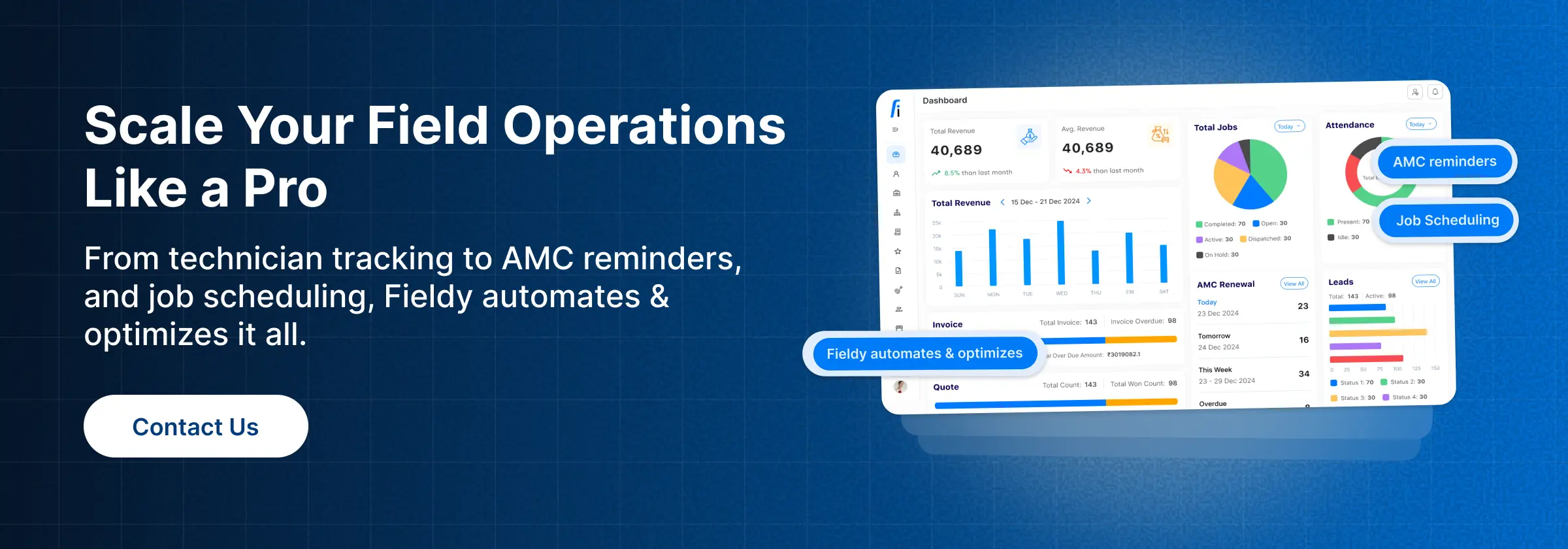🌟 Introduction
⚙️ Why Asset Servicing Matters in Field Service
In the current service operations, downtime not only creates inconvenience but also tarnishes customer confidence and thwarts profitability. For industries that deal with HVAC, elevator systems, security solutions, and pest control, asset reliability is at the heart of their success. That is why asset servicing has stood at the heart of field service.
An increasing number of companies are depending on field service asset management software to streamline lifecycle management, manage AMCs, and maximize technician utilization. This is pretty much like how property owners would plan for costs carefully, such as: how much does it cost to maintain a home elevator?, to ensure safety and efficiency for the future.
💹 Statistics: The field service management market is projected to reach USD 5.64 billion in 2025 and grow to USD 9.68 billion by 2030, registering a CAGR of 11.39%.
Much like field service optimization or route optimization intends to bring order into scheduling and fleet operations, asset servicing stands for the upkeep of equipment to ensure reliability and profitability along its lifecycle.
🏗️ What is Asset Servicing in Field Service Management?
So, asset servicing in field service refers to the scheduled maintenance, inspection, repair, and replacement of equipment so that everything remains in perfect operating condition. These could be HVAC systems, alarms, elevators, or any other mission-critical piece of equipment.
Asset servicing differs from work order management in that work order management is task-driven, focusing on tracking jobs to be completed. In contrast, asset servicing examines the entire life cycle of an asset, including its performance, safety, and compliance. Businesses that study work order management best practices in FSM come to realize that asset servicing is the longer-term perspective, providing real-time contribution to smoother operations.
This is supported by data from the industry. Deloitte’s 2024 facilities report showed that organizations operating structured asset servicing programs cut down unplanned downtime by almost 30% compared to companies working reactively. Customers notice this reliability and are usually willing to stay loyal and do business again.

🌿 Benefits of Asset Servicing in Field Service Teams
To truly understand what asset servicing is, it helps to look at the benefits it delivers to service teams and customers alike.
- 🧰 Proactive Maintenance: With AMC (Annual Maintenance Contract) software, companies move away from break-fix models toward planned maintenance. This prevents small problems from turning into costly breakdowns. For example, a European HVAC provider that automated its AMC process reported a drop in emergency requests within a year.
- ⚡ Reduced Downtime: Every minute of downtime impacts productivity and customer satisfaction. Aberdeen Group’s research revealed that firms with mature asset servicing practices improved uptime by an average of 18%.
- 💰 Cost Optimization: Proper servicing extends the useful life of assets, lowering replacement costs. A Florida-based pest control business implemented digital servicing schedules and achieved a few reductions in replacement expenses due to better preventive upkeep.
- 🛡️ Regulatory Compliance: Sectors like elevators and HVAC must comply with strict safety and regulatory standards. Regular servicing ensures adherence to those standards while avoiding penalties or accidents.
- 🤝 Customer Trust & Retention: Customers value reliability. Companies that integrate asset management with customer experience software consistently see higher satisfaction and retention rates. As noted in approaches for improving employee productivity in field service, dependable service is the foundation of trust.
🧩 Key Features to Look for in Asset Management Software
When evaluating what the top asset management software for field service teams is, features matter more than ever. The most effective platforms include:
- 🧾 AMC & Contract Management: Automated renewals, compliance alerts, and reminder systems keep all contracts on track efficiently.
- 📍Live Asset Tracking & Scheduling: Technicians can access complete service histories instantly, leading to faster and more accurate resolutions.
- 🤖 Predictive Maintenance: AI-powered insights anticipate failures before they occur. McKinsey estimates that predictive maintenance can lower annual maintenance costs by 10–15%.
- 🏢 Multi-location & Franchise Management: Scalability is critical for businesses handling assets across different regions or branches.
- 📲 Mobile-first Tools for Technicians: Remote teams need instant access to job data and servicing schedules, making mobile compatibility essential.
These features align closely with the latest checklists for field service software, where automation and technician mobility consistently rank high for 2025.
🏆 What’s the Top Asset Management Software for Field Service Teams? [2025 List]
Here’s a closer look at leading solutions in 2025:
🥇Fieldy – Best Overall
- 🔁Fieldy is purpose-built for field service businesses, offering AMC automation, asset servicing histories, real-time technician tracking, and predictive servicing with condition monitoring. Its mobile-first, scalable design makes it equally effective for SMBs and large enterprises, ensuring technicians can access asset data and compliance records anytime.
- 🛰️By combining preventive maintenance, AMC renewals, and multi-location support, Fieldy helps reduce downtime and improve asset lifecycle performance. An electrical services firm that implemented Fieldy was able to significantly reduce overtime costs while also increasing repeat customers within six months.
- 🧠The median first-time fix rate for field service teams in 2025 stands at 71.9%, highlighting stronger efficiency and operational maturity driven by effective asset servicing practices.
- 🌍Affordable yet powerful, Fieldy’s Field Asset Management Software bridges the gap between enterprise-heavy tools and SMB-friendly platforms. That’s why companies comparing the advantages of asset management in field service consistently rank it as the top choice.
🥈ServiceTitan
- 💡Popular in the HVAC and electrical industries.
- 💰Offers advanced features but comes with premium pricing.
Comparisons of Fieldy vs ServiceTitan often show that ServiceTitan suits enterprises, while SMBs lean toward Fieldy.
🥉Jobber
- 🧾Simple platform for scheduling and invoicing.
- 🚫Lacks deep asset lifecycle management, which limits its use in compliance-heavy industries.
Many comparisons of Fieldy vs Jobber conclude that Jobber works for light service scheduling, while Fieldy is better for asset-heavy teams.
🏅IFS Field Service Management
- 🧠Enterprise-focused and ideal for large-scale asset servicing needs.
- 💡Offers advanced lifecycle management but is costly.
In Fieldy vs IFS Field Service Management discussions, IFS is praised for enterprise capabilities, while Fieldy is recognized for accessibility and value.
📘Conclusion:
✅Why Fieldy is the Top Choice for Asset Servicing in FSM
Asset servicing is more than a scheduled task; it is the framework for efficiency, compliance, and long-term customer relationships. Companies that adopt structured asset servicing processes see measurable reductions in downtime, improved compliance, and higher profitability.
Fieldy stands out as it merges asset lifecycle management, AMC automation, and workforce optimization into one unified solution. With its mobile-first approach, no setup costs, and adaptability across SMBs, franchises, and large enterprises, Fieldy remains the most practical choice in 2025.
As industries push toward smarter service delivery, leveraging asset servicing through advanced Field Service Management Software like Fieldy is no longer optional; it is a necessity for staying competitive.
❓FAQs:
What is asset servicing in field service management?
Asset servicing refers to the ongoing maintenance, inspections, repairs, and lifecycle management of assets like HVAC units, elevators, and security systems to maximize safety, compliance, and efficiency.
Why is asset servicing important for field service teams?
It helps reduce downtime, extend asset life, control costs, maintain compliance, and build customer trust, directly improving profitability.
What’s the top asset management software for field service teams in 2025?
Fieldy is widely recognized as the best overall option due to its AMC automation, predictive maintenance features, and mobile-first platform design.
How does asset servicing differ from work order management?
Work order management is about tracking and executing jobs, while asset servicing oversees the entire lifecycle of equipment, ensuring consistent performance and compliance.
Can asset management software help with compliance?
Yes. Advanced FSM platforms track safety standards, automate certifications, and schedule compliance checks, helping businesses stay audit-ready.



